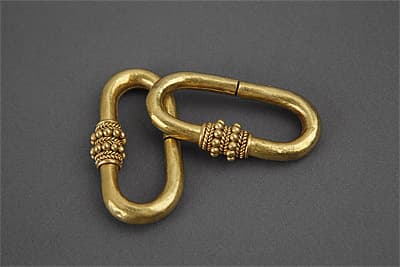FRÍAS style 200 – 600 AD
Ear ornament 200–600 AD gold , rolling, mould2.6 (h) x 5.6 (w) cm Museo Oro del Perú, Lima Photograph: Daniel Giannoni
Large ear ornaments were restricted to the elite, as personal attire marked status for ancient Peruvians. The Spanish called both the earpieces and the nobles who wore them orejones or ‘big-ears.’ These ear ornaments are similar to modern-day earrings, more than later versions. Subsequent cultures had large circular discs counterbalanced by long tubes that pierced the ear lobe. These were made from wood or hollow silver and gold cylinders.
Large ear ornaments were restricted to the elite, as personal attire marked status for ancient Peruvians. The Spanish called both the earpieces and the nobles who wore them orejones or ‘big-ears.’ These ear ornaments are similar to modern-day earrings, more than later versions. Subsequent cultures had large circular discs counterbalanced by long tubes that pierced the ear lobe. These were made from wood or hollow silver and gold cylinders.
Large ear ornaments were restricted to the elite, as personal attire marked status for ancient Peruvians. The Spanish called both the earpieces and the nobles who wore them orejones or ‘big-ears.’ These ear ornaments are similar to modern-day earrings, more than later versions. Subsequent cultures had large circular discs counterbalanced by long tubes that pierced the ear lobe. These were made from wood or hollow silver and gold cylinders.


